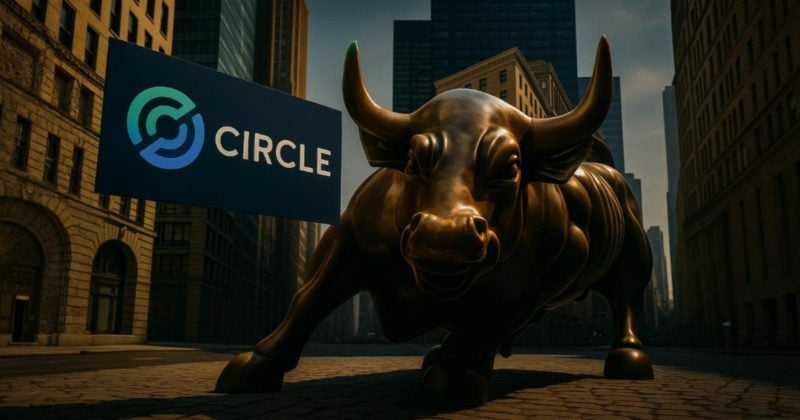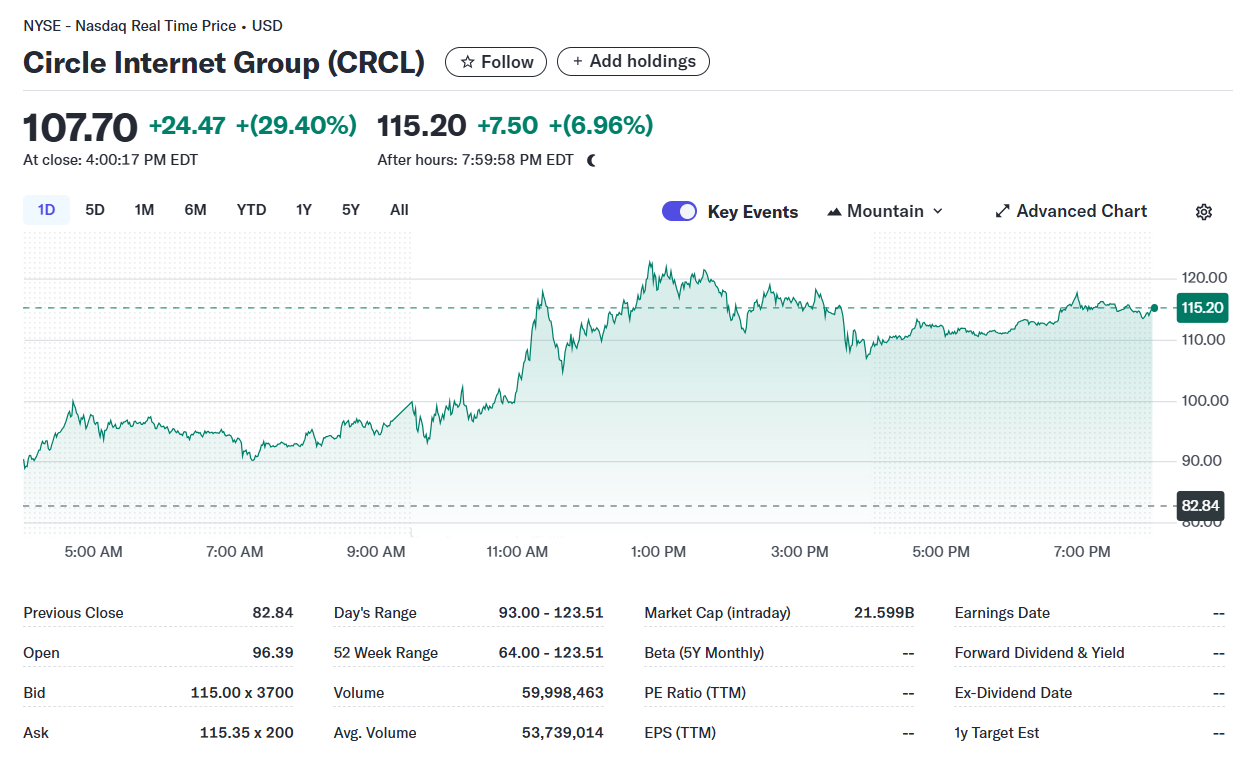Circle rejected Ripple’s $5 billion buyout — now valued at over $20 billion after NYSE debut

Key Takeaways
- Circle saw its market value exceed $20 billion following its NYSE debut.
- The company reportedly rejected Ripple’s $5 billion acquisition offer as it was seen as undervalued.
Share this article
Circle, the USDC stablecoin issuer, made a blockbuster debut on Wall Street this week, with shares soaring to as high as $123, briefly pushing its market capitalization close to $25 billion.
At the close of its second trading day on the New York Stock Exchange (NYSE), the stock (CRCL) settled at $107, giving Circle a valuation of more than $21 billion — nearly quadrupling not only its IPO pricing of $31 per share but also a reported $5 billion buyout offer previously made by Ripple.
“Now more than ever, USDC is the most trusted stablecoin. Building legitimate, regulated crypto products is tough. Doing so in 2013/14, when Circle was founded, was nearly impossible,” said Coinbase CEO Brian Armstrong in a statement.
“This is a tremendous milestone for both Circle and the industry, and shows that the demand for crypto is an unstoppable force,” said Binance CEO Richard Teng in a congratulatory note.


In April, Bloomberg reported that Ripple had made an acquisition offer for Circle valued between $4 billion and $5 billion, which was reportedly rejected as undervalued. Ripple CEO Brad Garlinghouse later disputed the report in a conversation with Georgetown Law professor Chris Brummer.
Circle itself also denied a separate report by Fortune suggesting it had held sale discussions with either Ripple or Coinbase, stating that the company is not for sale and remains focused on executing its long-term strategy.
Whatever the case is behind the speculated bid, Circle’s choice to stay the course with its IPO is now looking like a well-timed call.
The company is now part of a small, elite group of crypto-native firms that have successfully made the leap to public markets, following Coinbase, which went public in 2021 via a direct listing on Nasdaq, and eToro, which debuted on Nasdaq last month.
Circle is now officially a public company, listed on the @NYSE under $CRCL.
With @USDC, EURC, Circle Payments Network & more, we’re pushing forward a future of frictionless value exchange.
We are not just building financial products. We are building the money layer of the… pic.twitter.com/spBzjMzsVY
— Circle (@circle) June 5, 2025
Following Circle’s move, attention is now turning to Kraken and Gemini, two major crypto exchanges reportedly preparing for their US listings.
On Friday, Gemini confirmed that it had filed a confidential draft registration statement with the SEC for a potential IPO. Details such as the number of shares to be offered and the expected price range have not yet been disclosed, and no timeline for the public offering has been announced.
Stablecoins go prime time
The New York-based fintech company’s public debut is widely viewed as a watershed moment for digital assets, especially stablecoins, which have risen to prominence in legislative debates and institutional strategies.
“We have just gotten started in executing our ultimate mission and vision, and this transition into a public company is an inflection point for us as we move from the early adopter phase of this technology to widespread mainstream acceptance,” Circle CEO Jeremy Allaire said in a Friday post.
Wall Street’s warm reception of Circle signals that stablecoins are being taken seriously by traditional finance. And Circle’s regulatory-first approach could give it, or more specifically, its USDC stablecoin, a meaningful advantage just as Big Tech looks to integrate stablecoins into its ecosystems.
With a market cap of $61 billion, USDC ranks as the second-largest stablecoin, behind Tether’s USDT, which dominates the space with over $154 billion, per CoinGecko data.
Washington may soon deliver the real game-changer
While Circle’s IPO has jumpstarted institutional interest in stablecoins, the real momentum may soon come from Washington.


The GENIUS Act, a bill that would establish federal rules for stablecoin issuance by both banks and nonbanks, is nearing a final vote. If passed, it would provide institutions with a clear legal path to enter the market at scale.
Behind the scenes, executives at major banks are weighing whether to build, buy, or partner their way into the stablecoin space.
The Wall Street Journal reported last month that several of America’s largest banks are considering a joint stablecoin initiative to compete with digital asset platforms that are rapidly gaining market share.
Still in its early stages, the effort reportedly involves entities backed by JPMorgan Chase, Bank of America, Citigroup, Wells Fargo, and other leading US banks.
The combined momentum of Circle’s IPO and the impending regulatory clarity may accelerate those internal conversations.
Share this article



